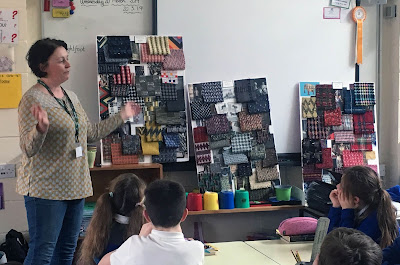Visit by Irene Steele, Designer at Linton Tweeds, Carlisle - 20th March, 2019
Today Irene Steele, who works as a Designer at Linton Tweeds came to school to tell us about her role as a designer.
She told us that Linton Tweeds for more than 100 years have been producing fabrics of the highest quality for fashion houses around the world. All of these fabrics are still designed and woven on site at their mill on Shaddongate, Carlisle – just as when we were first founded by William Linton in 1912. Linton Tweeds brand works with fashion houses in London, Milan and New York, in markets across Europe, North America and Asia, and with luxury brands such as Burberry and Chanel – who they have worked alongside ever since William Linton was introduced to Coco Chanel way back in 1924.
Running 16 hours a day, 14 looms create elaborate, beautiful tweed using a variety of techniques and yarns.
The video was shot by our artist during a recent visit to Linton Tweeds, showing the speed of the loom and the noise!
A third of each cloth produced at the mill is made from the 100% wool yarn twisted on site, but the other two thirds can be made up of any yarn of their partners’ choosing, so complex highly unique patterns and fabrics can be made.
A standard Linton tweed might comprise eight different types of yarn – whether that’s cashmere, silk, velvet ribbon, eyelash, lurex or anything else. Their couture tweeds can contain up to 300 different yarns.
Irene told us she works 18 months ahead, so the fabric herself and her colleagues are designing now will appear on catwalks in nearly two years time. Part of her design process involves trying out different coloured yarns and textures together by simply laying them side by side.
She gave us all a piece of black and white tweed on a piece of card, then gave us lots of examples of yarns for us to take a piece to put onto the fabric and encouraged us to try out different combinations.
The fabric made up of black and white shapes interlocking forming a pattern of tessellating shapes.
 |
| Choosing yarn |
We had a great time trying different colours and textures and making our own patterns.
 | ||
| Testing out colours and sticking yarn into our sketchbooks |
 |
| A great example - well done |
Irene then passed round samples of finished tweed fabrics together with photos of tweed clothing worn by models on the world's fashion catwalks.
It is amazing to think that this tweed has been designed and made in a small single storey factory in Carlisle. Thank you Irene for sharing this with us - it was fantastic!










Comments
Post a Comment